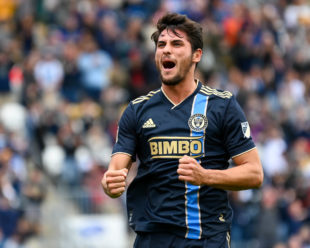Photo: Marjorie Elzey
In one sense, the Union’s 7–0 mauling of a hapless DC United side devoid of any coherence is simple: the Union played their perfect game against a team with no way to counter it. The press was effective, the defense held DC completely at arm’s length, and the offense blew up.
Were it not for the individual skill and ability of Taxi Fountas, DCU would not have threatened at all. Meanwhile, the Union should feel like scoring only seven goals was a little bit disappointing—it easily could have been nine or more, considering the chances they missed.
But that reductive summary doesn’t tell us how the Union did it, or if it’s repeatable.
The good news is that much of what transpired is, indeed, repeatable. The bad news is don’t expect to score that many goals again.
Get the ball to the attackers
In my column from last week, I said that everyone knows what ails the Union. The team’s big problem is/was linking defense to attack. If the Union didn’t generate turnovers in their preferred locations, high up the field, the team appeared to have no reliable method for getting the ball up to Dániel Gazdag and the strikers in good positions. The Union allergy to possession was so strong that too often it resulted in aimless clearances up the field, the definition of “hit and hope” soccer.
Against DC, the Union took their allergy pills and, rather than sneeze the ball away at every opportunity, they kept it and won the possession battle (52%–48%), made more passes than DC, and completed a higher percentage (83%—all stats from fbref.com). Of the starting outfield players, only Mikael Uhre, who attempted just 14 passes in his time on the field, had a completion percentage lower than 74%.
Part of this is the style match-up. Under Hernan Losada, DC were even more frenetic than the Union, though even they managed to connect more passes. They are less frenetic now, with Losada gone, but not really equipped to do things with the ball, either.
Don’t let that take away from what the Union did, though. Before this game, it wasn’t clear the Union had the capacity to possess the ball with intention. They clearly do—the collective passing and movement that led to Carranza’s second goal was a thing of utter beauty—and perhaps now understand that, even for a pressing and counterattacking team, possession can be useful.
The attackers must be clinical
The other half of my prescription for the Union was that, once the attackers got the ball, they had to be clinical.
Well, against DC, let’s just say they were. They scored seven goals with just 10 shots on target, including a saved penalty! They also put 43% of their shots on frame, which is excellent.
And exactly none of the goals were easy finishes. The easy chances, like Nathan Harriel’s open goal or Julián Carranza’s saved penalty, are the ones they duffed. Instead, there was, in order:
(1) Alejandro Bedoya controlling a long, lofted pass in order to beat a defender with one touch, then finishing with his weaker foot across the goalkeeper;
(2) Carranza with a bicycle kick;
(3) Carranza with a very deft redirection of a low cross through a defender’s challenge;
(4) Bedoya’s pinpoint header;
(5) Uhre’s movement putting a defender on the ground, followed by a composed finish past the keeper;
(6) Uhre taking a ball dropping out of the sky and putting it between the keeper’s legs; and
(7) Carranza making up for his missed penalty by using a defender to screen the keeper while he bent a shot to the far post, with his left foot.
That’s quite the finishing display.
It’s great to have proof that Union attackers can do it like that. It’s also very unlikely that multiple Union players will combine to be so clinical on the same day again, so savor it.
Miscellany
— All this talk of better possession play shouldn’t overshadow the utility of the long ball. José Martínez had a wonderful, composed game, dominating the center of the park. He also delivered that ball for the opening goal. It was exquisite.
— A day after learning that Sergio Santos was being transferred to FC Cincinnati, the players that made him expendable, Uhre and Carranza, really showed up in a big way. Losing Santos comes with a cost, but if it allows the Union to keep Carranza permanently (purchase with only $500k GAM, according to Tom Bogert), the team had to do it.
— Leon Flach, a bugbear for some fans who believe him to be an offensive black hole, had a great game, completing 82% of his passes and getting an assist on Carranza’s second.
— All four Homegrowns, back from the CONCACAF U-20 Championship, played. None really got a chance to shine, but Paxten Aaronson looked noticeably hungry, closing down hard and managing a couple shots that got blocked, while almost orchestrating a goal with a nifty cutback after beating a man to the endline. He might be breaking out, in which case, enjoy him while you can. He may very well be gone in the winter.
A great day at the office
That was arguably the best single-game performance in Union history. There aren’t many holes to pick in it, except to say the opposition was very, very bad. If the Union can bring just 50% of that effectiveness to the rest of their games, they will fight for the Supporters’ Shield.


How did THAT DC team beat Orlando and score 5 goals?
Orlando is also weirdly unpredictable, and maybe just bad.